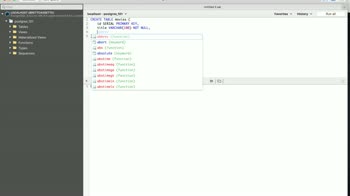
This is an extension from the SQL standar which does not allow zero-column tables. Zero-column tables are not in themselves very useful, but disallowing them creates odd special cases for ALTER TABLE DROP COLUMN , so it seems cleaner to ignore this spec restriction. CREATE TABLE using GUI of pgAdmin. Copy table structure into new table - Stack. How do you find the exact customer that the store manager is asking?

You may find the customer in the customer table by looking at the first name column to see if there is any value that begins with Jen. It is kind of tedious because there many rows in the customertable. Expand the database in which you would like to create the table. A wizard appears to create table. If the search expression can be matched to the.
We also can append ‘Where’ clause in above SQL script like. For a simple schema copy use the like clause. Why `SQL create table a LIKE b` not work for postgresql ? Is there a way to create a table that has the same structure as another table , but with additional columns?
Tables never have the same name as any existing table in the same schema. You have to be careful while using this command because once a table is deleted then all the information available in the table would also be lost forever. For ease of understanding, each process is complemented by screenshots taken while doing. I do not understand what is wrong with this query? If not what is the next best solution?
Create Table using command line in Linux. I need the statement because I use it to create the table on an remote server (over WCF). Oracle stores the definitions of temporary tables permanently similar to the definitions of regular tables. Step 1) Connect to the database where you want to create a table. To avoid “Peer authentication failed for user postgres ” error, use postgres user as a become_user.

A temporary table , as its named implie is a short-lived table that exists for the duration of a database session. No, you cannot do that, and I recommend that you do not create tables like that. Your table definition should look pretty much like your type definition does. There is no need for an intermediate type definition. Reasons: that will not make your schema more readable.
I need to export this data to a file, make a new table , then import that data into the new table … Boring. Note: All data, names or naming found within the database presented in this post, are strictly used for practice, learning, instruction, and testing. What is the correct behavior of a serial column when a table is created with LIKE ? The manual is silent on this. EXCLUDING documentation.
Attached is a patch to add this. The table will be owned by the user issuing the command. To begin with, we will create a tiny table with few random string values.
In the previous post, I copied table data into another table. In this post, I am creating a Copy of Table from another table of PostgreSQL. For PostgreSQL 1 I have worked on a feature called “identity columns”. I know I can create a table using names and types from an existing table.
I made to create the necessary primary table , reference tables , view, functions for the INSTEAD OF triggers, and finally, something to create an ordinary PostgreSQL table to compare against. I want to create a table having the same column names and types as an existing new datatype. Postgres uses trigrams to break down strings into smaller chunks and index them efficiently. The pg_trgm module supports GIST or GIN indexes and as of Postgres version 9. I need to create a table where the elements were previously selected from another table and they are all unique. Before we dig deeper into how to create new tables , we have to talk about a conceptual element of SQL: the different data types.
Let’s see what sorts of data we can put into an SQL table ! Note: in the current version of PostgreSQL there are more than different data types. I am learning PostgreSQL and trying to figure out how to create a temporary table or a WITH declaration that can be used in place of regular table , for debugging.
Keine Kommentare:
Kommentar veröffentlichen
Hinweis: Nur ein Mitglied dieses Blogs kann Kommentare posten.